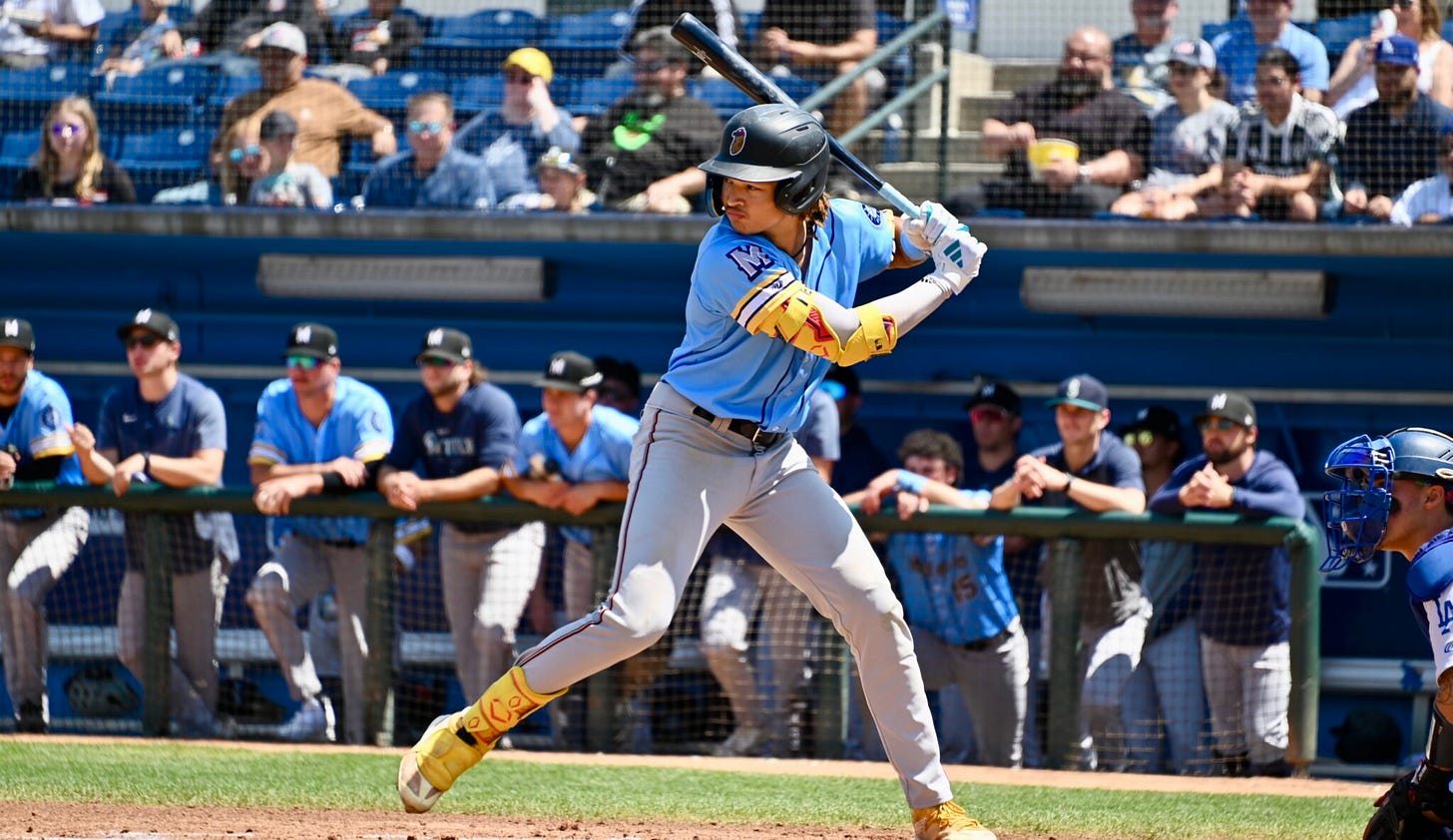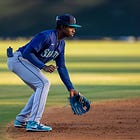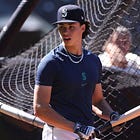Peete to CF, Emerson to 3B among potential value-altering position swaps for Mariners' top prospects
Nothing official to report here, but let's explore.
We’ve talked since Draft Day about how Colt Emerson likely isn’t a shortstop in the big leagues, but where he ends up isn’t exactly clear. The same goes for arms that may or may not project as a starting pitcher, and catchers who won’t, well, catch.
Here are some key prospects whose positions and roles impact their future values the most.
Colt Emerson
Emerson does a lot of things pretty well at shortstop, but he’s not a quick-twitch athlete, suggesting range will lack as he continues to mature physically. There’s a better chance he can manage at second base, but this is a Kyle Seager situation where it behooves the organization to go from shortstop to whatever position they believe he can flourish long-term.
It’s a nice bonus that the hot corner leaves second base for Cole Young, and potentially Felnin Celesten at shortstop, and it helps that Emerson’s bat may ultimately play anywhere on the field.
Traditionally, third base is among the elite power positions in baseball, but hitting is hitting and even a .280/.370/.450 slash plays well there. Those three numbers would have ranked No. 1, No. 2, and No. 8 among third basemen in 2024, likely good for the third-best wRC+ in the 125-130 range.
I’ve been forecasting Emerson off of shortstop for two years, but there’s a potentially meaningful difference between Emerson at second versus third, too, and if this were 20 years ago it would mean even more.
Over the last five seasons, the top three second basemen offensively have been Jose Altuve (136 wRC+), Ketel Marte (131), and Brandon Lowe (126). Emerson’s high-range projection of 125-140 wRC+ marks put him in the elite category at the position, both short-term and especially over the long haul. In a vacuum, this is the better value, as it’s typically more difficult to find such bats at second versus its left-corner brethren.
We’re in an era, however, when it’s nearly as tough to find high-quality third basemen, and Emerson’s glove has a chance to flourish there versus perhaps only ‘hold up’ at second.
While my future value on Emerson doesn’t change with a move from shortstop to third base because I’m already projecting the switch, others’ evals may change when the time comes.
Harry Ford
Ford’s long-term position must remain behind the plate for him to profile as an everyday player. That’s my estimation anyway, and it jives with every single scout I’ve spoken with about the Mariners’ 2021 first-round pick.
The bat has potential — and he’s just 22 this month — but considering his offensive compass as a .250 hitter with plus on-base skills and fringe-average to average power (despite raw power pushing him another grade north), he’s rather ordinary unless he’s donning the tools of ignorance.
I wrote in the Rankings I don’t see Ford’s defensive skill set including second, short, or center, despite his arm strength and foot speed, and third base seems like a stretch too, considering he’s never regularly been asked to field ground balls. His athleticism beyond catcher seems corner-outfield bound. Such a swap puts a lot of pressure on his bat to perform.
Ford the corner outfielder is not a Top 15 prospect in this system, and that may extend beyond the Top 20. If he doesn’t catch at least half the time, I don’t see a way he’s any kind of regular in the big leagues.
Lazaro Montes
Montes is an outfielder right now, but it’s probably a 35-grade future there, and he’s yet to play an inning at first. But his value comparison for me isn’t outfield versus first base, it’s first base versus designated hitter because of the zero chance he’s a value of any kind in right field.
Pure DH territory is a tough one with only one, squint-limited potential outcome: elite hitter, such as David Ortiz, who played just 2166 innings in the field in his 20-year career, a mere 472 over the final 11 — he never started more than 69 games in the field in a season and surpassed 400 just once. For context, that’s the typical yearly innings count of a true No. 2 backstop in Major League Baseball the last few seasons.
Despite the DH being in both leagues now, the inability to provide some reasonable defensive value substantially reduces the value of Montes’ bat and could result in him having problems staying in the lineup sans a premium bat.
That’s an awful lot to ask of any player, let alone a 20-year-old prospect, so Montes having a reason to own a glove is imperative to his future.
Tai Peete
Peete played shortstop and pitched in high school, but he’s not built to stay there and spent time at third base and in the outfield in 2024. I saw him excel in left for three starts in four days, and he tallied 135 innings out there last season. But he also got a taste of center field (70 innings) and that may very well become a legitimate possibility in 2025.
Peete has plus speed and arm strength and seemed unfazed by moving around the diamond last season, suggesting a new, regular position in 2025 won’t greatly impact his much-needed development in the batter’s box.
But center field versus left field makes a big difference in the long-term projection, reducing the requirements at the plate and increasing his chances to get to the big leagues.
It’s among the more exciting possibilities and potential outcomes for a Mariners prospect, and if he takes to it anywhere near as well as Jackson Merrill did it’ll prove to be the only move the club should consider.
The list of former pro shortstops that ended up having great careers in center includes Robin Yount and Adam Jones. It’s not an easy transition, however, and doesn’t always stick. The Mariners tried Ketel Marte there in Triple-A Tacoma under the tutilege of manager Pat Listach, who made the same transition in his playing days, and the Arizona Diamondbacks gave it another go in the big leagues a year later, but Marte never took to it.
I think Peete will.
Michael Arroyo
Arroyo, a natural shortstop who has already moved to the right side of the diamond, needs to hang onto second base rather than requiring a move to third or left field.
He doesn’t have the quick twitch to play short or center, and it’s a slight stretch at second but he’s making the routine plays.
A move to third adds to what he’ll need to do at the plate to play every day and it’s the long-term power I don’t believe in — at least not to third-base levels.
If Arroyo moves to the outfield I think it will be out of necessity or the organization, rather than he’s simply not good enough to manage at second, but I’m keeping an eye on his conditioning. He’s a stocky 5-foot-8 and already is about average concerning lateral range at second base. He can’t afford to go backward there much.
I’ve comp’d Arroyo to Howie Kendrick, who ended up plenty good at second early in his career and was passable in left into his mid-30s. But Kenrick did a great job staying in shape.
Jeter Martinez
The 19-year-old Martinez is years from the majors and his long-term role does not have to be decided anytime real soon, but should he continue to struggle with major control problems (16.8% walk rate in 2024), that’s exactly what could happen.
Again, I reiterate, this is not a current projection, just a worst-case scenario, but if it’s necessary it takes Martinez from a potential mid-rotation role to hoping he can get outs in high-leverage situations and potentially landing as a middle reliever.
To illustrate the value differential, look at the free-agent value of even No. 4 starters versus non-elite relievers.
Matt Boyd received $14.5 million per season for two years from the Cleveland Guardians this winter. Detroit handed Alex Cobbs $15 million guaranteed on a one-year deal.
The likes of setup types Yimi Garcia ($7.5M AAV) and Paul Sewald ($7M), however, show the difference, and true long-middle arm Jakob Junis signed for $4.5 million.
Martinez is just getting started and has plenty of time to get it right — and he’s not alone in this battle, it’s prominent among young arms of the same raw ability.







This a great piece. Thx Church.